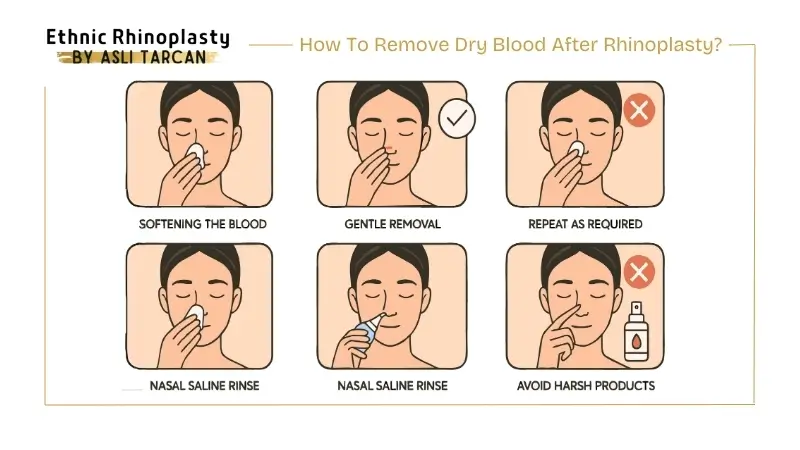If you experience a nosebleed 2 weeks after rhinoplasty, it’s an alarming situation. While minor bleeding is normal in the early days after nose surgery, bleeding at the 2- week often confuses patients.
At this stage, the nasal tissues are fragile and sensitive. For example, even dryness inside the nose or light touching can reopen tiny blood vessels. In some cases, bleeding may result from a reaction to stitches, infection or high blood pressure.
In this article, we’ll discover the reason behind bleeding after rhinoplasty, what’s considered normal, the trigger point, how to manage it, and when to seek a doctor.

Nosebleeds after rhinoplasty is also known as epistaxis. Although it is a common mild occurrence that can resolve on its own within a few days. The nose bleed is spotted especially within the first 24-48 hours after surgery.
Why Do You Get Nosebleeds After a Nose Job?
If there is a constant stream of bright red blood from the nose that doesn’t stop then it’s important to seek medical advice. Besides surgical trauma, there can be multiple causes, that include:
- Increased blood pressure
- Stress
- Excessive fatigue
- Accidental trauma
- Dry nasal lining
- Nose blowing
- Infection
- Strenuous activities
Most mild nosebleeds are managed by simply dabbing the nose gently with gauze. While in severe cases, nose packing or tampons are used.
Are Nosebleeds Normal After Rhinoplasty?
Yes, nosebleeds are entirely normal after rhinoplasty. The nose consists of tiny blood vessels that are protected by the delicate nasal linings. During rhinoplasty, the nasal tissues are manipulated and may become sensitive. This leads to bleeding which is part of the recovery process.
Doctors recommend replacing the gauze every few hours, avoiding exertional activities. Also contact doctors immediately if the bleeding persists even after a few days.
Mild Bleeding vs. Severe Bleeding After Rhinoplasty
Many people use the terms nose bleed and epistaxis interchangeably, but they have slight differences. Here’s a comparison:
| Feature | Mild Bleeding | Severe Bleeding |
|---|---|---|
| Definition | Light bleeding or spotting from the nostril | Profuse or persistent nasal bleeding |
| Typical Timing | First 1–2 weeks post-op | Can occur anytime, concerning after 2 weeks |
| Volume of Blood | Few drops or light spotting | Continuous flow |
| Triggers | Dryness, crusting, mild irritation | Trauma, infection, uncontrolled pressure |
| Duration | Stops within 10–15 minutes with pressure | Lasts >20 minutes or recurs frequently |
| Management | Home care; saline spray, elevation, cold compress | Requires ENT or surgeon intervention |
| Risk Level | Generally low | Potential complication or emergency |
How Long Does Your Nose Bleed After Rhinoplasty?
After rhinoplasty, bleeding usually subsides within 4 to 7 days. Even the swelling and tenderness resolve over the next 1 to 2 weeks. It takes a few weeks for your nose to completely heal, the bleeding and pain gradually becomes less with each passing day.
In the first week after surgery, the nose may feel blocked due to packing and the accumulation of blood and mucus, making it difficult to breathe. The nose is also fragile initially, so treat it with care.
For post-operative pain, doctors prescribe pain killers. Tylenol can be taken if mild pain, but avoid aspirin or NSAIDS as they can thin blood and promote bleeding. Also, make sure to check the severity and duration of nosebleeds, if any concerning symptoms arise, consult your doctor quickly.
What To Do Immediately After A Nosebleed?
Experiencing nosebleeds during healing after rhinoplasty is a quite panicking situation. Here are essential steps to take when bleeding starts:

Stay Calm & Composed
Staying calm is the first thing to do. Otherwise, both heart rate and blood pressure will rise. This can deteriorate the bleeding process more. By staying composed, the body also gets stable which supports clotting and allows the nose to get settled.
Sit Upright And Lean Forward
After controlling the nose bleed, make sure to sit upright and lean forward. This will reduce the blood pressure towards the nose. Tilting forward will prevent the blood from going down the throat which leads to vomiting and nausea.
This posture ensures the blood exits through the nostrils to monitor the bleeding effectively.
Applying Pressure
If you pinch the soft part of your nose for at least 10 minutes without releasing it, then the bleeding is likely to stop. This will compress the blood vessels over that area and promote clotting. Beware to not press the bridge of the nose directly or disturb the surgical site.
Applying Cold Compress
An icepack or a cold compress on the nose will constrict the blood vessels and reduce the blood flow. Keeping a soft cloth or towel with yourself is important. Also, avoid applying direct pressure to the nose.
How To Prevent Further Nose Bleeds?
After surgery, the nasal tissues get delicate which lead to nose bleeding. However, there are some effective tips that can prevent or help stop post-surgery nosebleeds.

- Humidification: Keep your nose moist by using a humidifier or saline nasal sprays. This will prevent dryness.
- Gentle Nasal Care: Don’t blow your nose forcefully and avoid removing scabs. It will ward off any trauma to the healing nasal tissues.
- Head Elevation: Keep your head elevated to reduce pressure on the nose and decrease blood flow.
- Medication: Before you take any medication, consult your surgeon and ask about adjustments.
- Cold Compression: Keeping a cold compress on your nose will stop the blood flow.
- Stay Hydrated: Having plenty of fluid intake can prevent nasal passages from getting dry.
- Avoiding Irritants: These include smoke, strong odors, or pollutants which can trigger nose bleeding.
- Contact Surgeon: If nose bleeding gets excessive, inform your surgeon about concerning symptoms and for further guidance.
What Are The Risk Factors For Bleeding After Rhinoplasty?
There are many risk factors that increase the chances of bleeding after rhinoplasty. Some of them are as follows:

- Medications: Using blood thinning medications such as NSAIDS which include aspirin and ibuprofen increase bleeding. However, herbal supplements such as ginkgo biloba can also elevate the risk of bleeding.
- Alcohol Consumption: Avoid alcohol consumption after rhinoplasty as it can thin the blood and cause bleeding.
- Smoking: It adversely affects the blood circulation and oxygen supply to the tissues. This will slow down the healing process and increase bleeding complications after rhinoplasty.
- Patient Health: Underlying medical conditions such as clotting disorders, hypertension, or excessive bleeding, will exacerbate the chances of bleeding.
- Surgical Technique: Bleeding risks depend upon the extent and complexity of nose surgery. If the surgery is more invasive then it can give rise to excessive bleeding.
- Post-operative Care: If the patient’s not able to follow the surgeon’s instructions or follow inadequate post-operative care, then bleeding occurs.
- Infection: Post-surgery infections, along with inflammation and tissue damage, can increase the likelihood of bleeding complications.
How To Remove Dry Blood After Rhinoplasty?
Cleaning dried blood after rhinoplasty is a careful process. It can reduce irritation or disruption of the healing process. Here are several steps to efficiently clean off dried blood:

- Softening The Blood: Take a small cotton ball or a gauze pad and soak it in saline solution or sterile water and let it moist. Then, apply gently on the dried blood to soften it.
- Gentle Removal: Carefully dab the cotton ball over the dried blood to prevent any additional trauma over the nasal area. This will remove it gently.
- Avoid Scrubbing: Scrubbing or picking at the dried blood can cause irritation and affect the healing process adversely.
- Repeat As Required: Continue dabbing the dried blood until it becomes moist. It doesn’t come off easily, thus requires continuous exertion.
- Nasal Saline Rinse: The surgeon usually recommends doing nasal saline rinse. This will help soften the dried blood and help it be removed from the nasal passages.
- Avoid Harsh Products: Avoid using alcohol-based products, abrasive cleaners, or tissues, as they may damage the nasal tissues.
Is It Normal To Have Pinkish Discharge After Rhinoplasty?
Yes, pinkish fluid discharge is common after surgery. It results due to the manipulation of nasal tissues, deranged blood vessels, and the body’s natural healing process.
This discharge consists of blood and clear fluid that drains from the nasal passages. It continues for a few days and lasts for about a week. This is usually observed during the initial stage of the healing process.
If the discharge becomes excessive, foul smelling with severe pain, fever, or increased swelling, then consult your surgeon. It’s important to monitor the discharge and strictly follow post-operative instructions.
Post-Rhinoplasty Bleeding Timeline
It’s important to understand the post-rhinoplasty bleeding timeline for managing complications. Here’s what to expect week by week:
Week 1 – Critical Recovery Period
During the first week of recovery, swelling occurs around the nose and bloody discharge may be present. Use a gauze pad or cotton balls to gently dab under the nose.
If the nosebleed persists more than 1 week after rhinoplasty, then it is an alarming situation and needs to get handled immediately.
Week 2 – First Look of The Final Result
In the second week, the bandages and splints are removed during the follow-up visit. You might feel energetic and ready to go to work. However, there is still some bruising or swelling present over the nasal area.
If you experience a nosebleed two weeks after rhinoplasty instead of light spotting, report it to your surgeon.
2-3 Months – Nose Shape Begins To Settle
During this time, the healing process is almost complete. The face starts to look fine again with improved nose shape and size.
If a patient experiences nose bleeds 3 months after rhinoplasty, then it’s not common and needs to be addressed quickly. It might be due to trauma, dry nasal lining, infections or inflammations, etc.
6-12 Months – The Final Nose Shape
During this time, the nose is fully healed. The final shape of the nose gets improved. Any swelling at the nasal tip completely resolves.
If there is bleeding 12 months after rhinoplasty, it may be due to external trauma, dryness, or nasal infection. The condition needs to get the surgeon’s attention.
Immediate Vs Delayed Bleeding After Rhinoplasty
It’s essential to understand the timing and characteristics of bleeding. The table below differentiates between immediate and delayed bleeding after rhinoplasty:
| Feature | Immediate Bleeding | Delayed Bleeding |
|---|---|---|
| Onset | Within the first 24–72 hours post-surgery | Occurs 1–2 weeks (or later) post-surgery |
| Cause | Surgical trauma, dissolving clots, residual anesthesia effects | Fragile vessels reopening, scab dislodgement, dryness, infection |
| Volume | Usually moderate; expected initially | Usually light spotting; heavy flow is abnormal |
| Duration | Gradually decreases after first few days | Short episodes; prolonged bleeding needs evaluation |
| Management | Head elevation, nasal dressing, saline spray | Saline spray, cold compress, avoid strain; contact surgeon if persistent |
| Warning Sign | Heavy flow not stopping in 20–30 min | Bright red, recurrent, or high-volume bleeding beyond 2 weeks |
When To Seek Medical Attention
Light bleeding is a sign of normal healing. But sometimes. rhinoplasty nosebleeds signal a serious underlying issue. Here are some symptoms that need medical attention:
- Severe Pain: If the pain is intense and does not subside even after taking medicines, then there are higher chances of infection or internal issues. This needs serious attention from a surgeon.
- Excessive Bleeding: Continuous blood loss that soaks gauze indicates a broken blood vessel.
- Persistent Bleeding: Bleeding that continues for several days without improvement requires evaluation, as it can lead to delayed healing and irritation.
- Fever Or Signs Of Infection: Signs of infection, such as fever, foul-smelling discharge, or increasing redness and swelling, can lead to abnormal bleeding. Immediate treatment can prevent further complications.
Frequently Asked Questions
Why is my nose bleeding 3 weeks after rhinoplasty?
It is due to dryness, minor irritation, crusting, trauma, etc.
Is it normal to bleed 2 weeks after septoplasty?
If there is fresh, persistent bleeding then it can be a concerning situation.
Why is my nose ring bleeding after 2 weeks?
Nose piercing or nose rings can cause bleeding due to irritation, infection, or accidental trauma.
What are the signs of rhinoplasty rejection?
There is redness, discharge, or changes in nose shape.
What happens if I hit my nose 3 weeks after rhinoplasty?
It can affect the healing process and cause bleeding or swelling.
Will I look normal 3 weeks after rhinoplasty?
Yes, most of the bruising is gone. Full results take about 6-12 months.
Why is my nose still blocked 2 weeks after septoplasty?
Nasal blockage is due to nose packing, crusting, or swelling. Regular saline rinses will solve this problem.
What are signs of infection after sinus surgery?
Fever, foul-smelling discharge, redness around the eyes or nose.
What does dissolvable nasal packing look like when it comes out?
It is a dark jelly-like substance that comes out during nasal irrigation.
How to tell if a septum is infected?
There is redness, swelling, pain, discharge, soreness, and pus.


